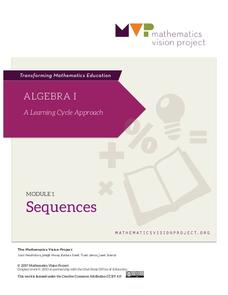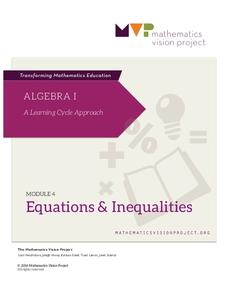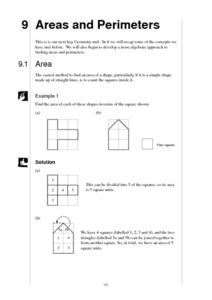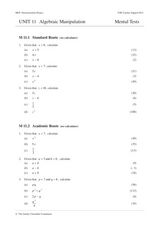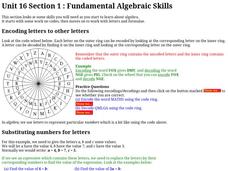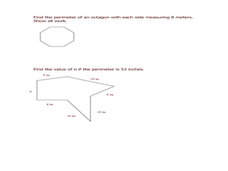Mathematics Vision Project
Module 1: Sequences
Sequences are all about recognizing patterns. A module of 11 lessons builds pupils' understanding of sequences through pattern analysis. The practice connects the analysis to linear and exponential equations. This is the first module in...
EngageNY
Replacing Letters with Numbers
When did letters become the same as numbers? Scholars learn about substituting numbers for letters to evaluate algebraic expressions in the seventh part in a series of 36. The lesson focuses on expressions related to geometry, such as...
Balanced Assessment
Sharp-Ness
Transform pupils into mathematicians as they create their own definitions and formulas. Scholars examine an assortment of triangles and create a definition and formula for determining the sharpness of the vertex angle. The groups of...
Intel
Pedal Power
Show your classes the importance of mathematics in something as simple as bicycle design. The final lesson in the six-part STEM series has each group research a different aspect of the bicycle. Learners use mathematical formulas, linear...
EngageNY
Mid-Module Assessment Task - Algebra 2 (Module 1)
Challenge classes to think deeply and apply their understanding of polynomials. The assessment prompts learners to use polynomial functions to model different situations and use them to make predictions and conclusions.
Geometry Accelerated
Accelerated Geometry Review Sheet
Your geometry learners use their knowledge of various geometric concepts to write proofs. Starting with givens containing parallel line segments with transversals and triangles and quadrilaterals, and the mid-point and distance formulas;...
Mathematics Vision Project
Module 4: Equations and Inequalities
Can you justify that mathematically? Help learners see the process of solving as using mathematical properties rather than a set of steps to memorize in the fourth module of a nine-part Algebra I series. The module contains six...
Centre for Innovation in Mamatics Teaching
Areas and Perimeters
Cover some serious area in your geometry curriculum with this collection of worksheets. After first introducing the concept of area using the tiling method, this resource continues on to teach learners how to use...
PBS
Working with Coordinate Planes: Assessments
It's time for scholars to show what they know about coordinate planes with a collection of three assessments. The exams' objectives include plotting points on a single grid, measuring using the distance formula, and identifying...
University of Colorado
Distance = Rate x Time
Every year, the moon moves 3.8 cm farther from Earth. In the 11th part of 22, classes use the distance formula. They determine the distance to the moon based upon given data and then graph Galileo spacecraft data to determine its movement.
Mathematics Vision Project
Quadratic Functions
Inquiry-based learning and investigations form the basis of a deep understanding of quadratic functions in a very thorough unit plan. Learners develop recursive and closed methods for representing real-life situations,...
Balanced Assessment
Frosting on the Cake
Party planners need algebra too! Here, pupils decide the perfect size of a cake based on available ingredients. They use the concepts of area and perimeter to make their conclusions.
Curated OER
Algebraic Expressions
This all-encompassing lesson plan immerses your math class in the world of algebraic expressions. Written details are provided to guide you in guiding them to identify the parts of an expression and simplify them. Sample problems are...
Curated OER
Integrated Algebra
For this algebra worksheet, young scholars review a variety of math concepts as related to algebra. They solve problems on statistics, factoring and solving equations. There are problems involving geometric formulas and shapes.
Curated OER
Algebraic Manipulation
In this algebraic manipulation worksheet, students examine a given number grid, find the pattern and determine an equation to fit the situation. They calculate the area of given rectangles. Students solve real life problems using given...
Curated OER
Using the Distance Formula
In this distance formula activity, learners solve and complete 30 various types of problems. First, they find the exact distance between each pair of points and make a sketch of the situation. Then, students find the center, horizontal...
Curated OER
Graphs of Formulas
In this worksheet students fill out a function table after reading a short word problem. This is a good way for students to practice the necessary skills for solving word problems or setting up algebra equations.
Curated OER
Regents High School Examination Integrated Algebra
For this integrated algebra worksheet, high schoolers complete 39 multiple choice problems. This is a copy of the 2009 State of New York exam.
Curated OER
Integrated Algebra
In this algebra worksheet, students solve equations, graph linear functions and find the angles in triangles. There are 39 questions.
Curated OER
Integrated Algebra Practice
In this Algebra I worksheet, 9th graders solve problems involving conversions within measurement systems. The one page worksheet contains a combination of thirteen multiple choice and free response questions. Solutions are...
Curated OER
Formulae: Mental Tests
In this formulae worksheet, students find the value of a function, compute total cost, and simplify algebraic expressions. This four-page worksheet contains 30 problems.
Curated OER
Fundamental Algebraic Skills
In this fundamental algebraic skills worksheet, students solve 11 various problems that include various algebraic skills. First, they use the coded wheel to answer 2 questions about a message. Then, students substitute the given numbers...
Curated OER
Algebra/Geometry Institute Summer 2007 - Perimeter of Polygons
Sixth graders find the perimeters of polygons and use perimeters to form polygons. In this perimeter lesson, 6th graders study vocabulary associated with finding perimeter such as polygon, line segment, variable, and formula. They make...
Curated OER
PRE ALGEBRA
Eighth graders find missing angles of triangles, quadrilaterals and angles formed by parallel lines cut by a transversal. They use area formulas to find the area of a figure; find the complement and supplement of a given angle; and know...
